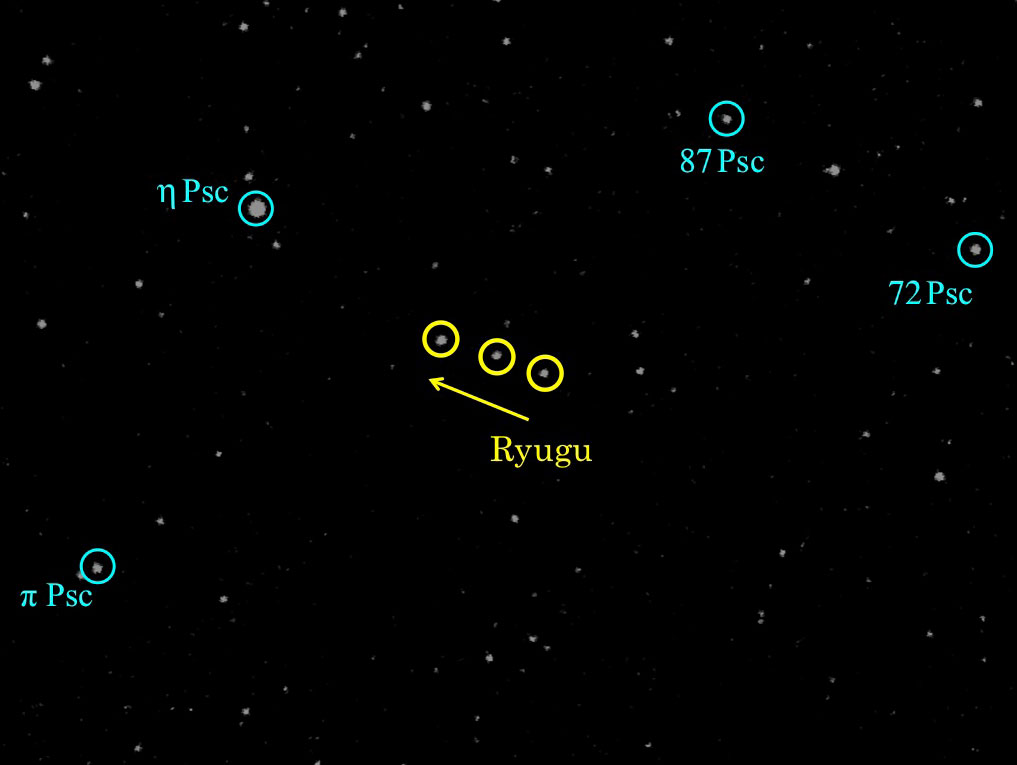Hayabusa2 is currently operating its ion engines as the spacecraft approaches asteroid Ryugu. But on May 11, the ion engines were temporarily stopped so that the onboard Star Tracker (see note 1) could take a photograph of Ryugu. This observation of the direction of Ryugu from the spacecraft will be used for optical navigation (see note 2).
The Star Tracker took three sets of three images approximately one day apart, between May 11 - 14. The three images in each set were separated by several hours. The images were all taken successfully and were used to accurately measure the position of Ryugu in each image. We have now begun to use this data to determine the accurate orbits of both spacecraft and asteroid.
-
 Figure 1: Photograph of Ryugu using the Star Tracker. The celestial body within the yellow circle is Ryugu, moving from right to left across the image. The photographs were taken at approximately 01:00 on May 12, 02:00 on May 13 and 01:00 on May 14 (JST). These are taken from the spacecraft in the direction of Pisces. "Psc" is an abbreviation of Pisces. The field of view is 9°×7°.
(Image credit: JAXA, Kyoto University, Japan Spaceguard Association, Seoul National University.)
Figure 1: Photograph of Ryugu using the Star Tracker. The celestial body within the yellow circle is Ryugu, moving from right to left across the image. The photographs were taken at approximately 01:00 on May 12, 02:00 on May 13 and 01:00 on May 14 (JST). These are taken from the spacecraft in the direction of Pisces. "Psc" is an abbreviation of Pisces. The field of view is 9°×7°.
(Image credit: JAXA, Kyoto University, Japan Spaceguard Association, Seoul National University.)
-
 Figure 2: Animation of the previous figure. Features that seem to appear and disappear are image noise.
(Image credit:JAXA, Kyoto University, Japan Spaceguard Association, Seoul National University.)
Figure 2: Animation of the previous figure. Features that seem to appear and disappear are image noise.
(Image credit:JAXA, Kyoto University, Japan Spaceguard Association, Seoul National University.)
Note 1: The Star Tracker is an instrument typically used for estimating the orientation of the spacecraft by measuring the position of surrounding stars. However, in this mode, it can be used to take images like a camera.
Note 2: The spacecraft position is usually estimated by communicating with the spacecraft using radio waves. This is known as "radio navigation". But just before Hayabusa2 arrives at Ryugu, the trajectory of the asteroid and spacecraft needs to be known as accurately as possible. We, therefore, use image data to measure the direction of Ryugu from Hayabusa2. Combining this with the radio navigation, the orbit of both asteroid and spacecraft can be estimated to greater precision. This is referred to as "optical navigation".
Hayabusa2 Project
2018.05.15

